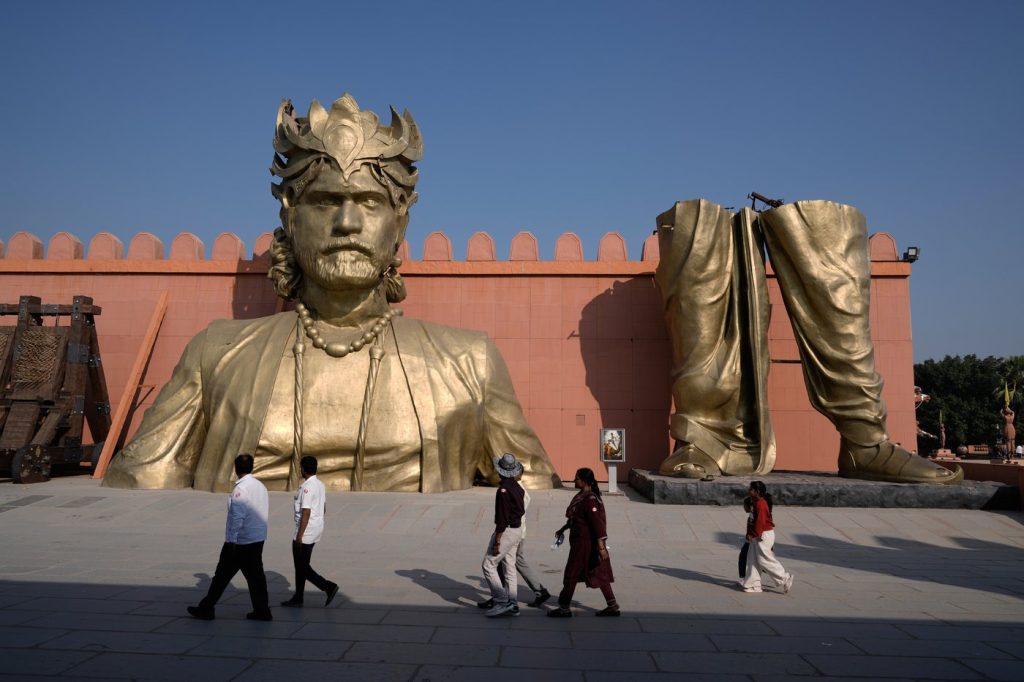Entertainment
Tollywood Takes Center Stage: How Telugu Cinema is Thriving

The Telugu-language film industry, known as Tollywood, is rapidly emerging as a formidable competitor to Bollywood, India’s traditional hub of cinema. Based in Hyderabad, Tollywood has gained international fame with blockbuster films such as “RRR” and “Baahubali.” As the industry diversifies its offerings and expands its audience reach, it is reshaping the landscape of Indian cinema.
Tollywood primarily operates out of the bustling city of Hyderabad, which houses the vast Ramoji Film City. Covering 1,666 acres (approximately 674 hectares), this facility is recognized by Guinness World Records as the largest film studio complex globally. Despite producing around 300 films annually—fewer than Bollywood—Tollywood has carved out a distinct identity marked by high-octane action, mythic narratives, and grand visual styles.
The industry’s rise accelerated during the coronavirus pandemic, as the proliferation of streaming services allowed regional films to connect with broader audiences. This expansion coincided with Bollywood’s struggles to attract viewers back to theaters, often criticized for repetitive storylines and remakes. Tollywood has successfully balanced excitement and emotional depth, appealing to diverse tastes.
Filmmaker T.V. Ravi Narayan notes, “Telugu people have a lot of interest in movies. They are cinema lovers.” This passion allows audiences to embrace a wide range of genres, from high-budget spectacles like “Baahubali” to more intimate biopics and realistic dramas.
Distinctive Features of Tollywood Films
Tollywood is characterized by its dynamic storytelling and impressive action sequences, often incorporating heavy visual effects. The films typically blend family drama, action, and elements of mythology, frequently marketed as “pan-India” releases and dubbed in various regional languages. The emphasis on crowd-pleasing visuals paired with catchy songs and choreographed dances makes these films popular among viewers.
Many Tollywood productions are also adapted into Hindi films, which has proven to be an effective strategy for expanding the reach of Telugu cinema. Dubbing, where voice-overs are recorded in other languages, enhances accessibility and broadens the audience base. In addition to blockbuster films, the industry produces smaller, low-budget projects that delve into themes of social issues and regional culture, many of which are released directly on platforms like Netflix and Amazon Prime.
The Fandom and Cultural Impact
Tollywood stars such as Mahesh Babu, Allu Arjun, Prabhas, and N.T. Rama Rao Jr. enjoy immense popularity, drawing fan bases that span generations. Movie releases are often timed with regional festivals and are preceded by elaborate music launch events that attract tens of thousands of fans.
This fervent fandom has cultivated a unique culture, where followers engage in activities ranging from charity drives to acts of worship for their favorite stars. In theaters, it is common for fans to celebrate releases with dancing, whistling, and throwing confetti. Billboards of major stars are ubiquitous in Hyderabad, further showcasing their influence.
Tollywood’s impact extends beyond the screen; many actors have transitioned into politics, with notable examples like N.T. Rama Rao, who founded the Telugu Desam Party in 1983 and became the chief minister after a stunning electoral victory against the Congress Party.
Factors Behind Tollywood’s Rapid Growth
The last decade has seen Tollywood redefine India’s entertainment industry, gaining international recognition and reshaping perceptions of regional cinema. Much of this success is attributed to filmmaker S.S. Rajamouli, known for his grand storytelling and innovative filmmaking techniques. His recent blockbuster, “RRR,” became a global sensation and won an Oscar for best original song.
Rajamouli’s earlier works, including the two-part “Baahubali” series, broke numerous box-office records in India. His upcoming film, “Varanasi,” expected to release in 2027, promises to blend time-travel with Hindu mythology, further solidifying his status in the industry.
Tollywood also shares similarities with Bollywood in terms of revenue generation, relying on theatrical releases, television, music rights, and brand partnerships. It is recognized as India’s second-highest-grossing film industry, trailing only Bollywood. Although the industry is influenced by a few powerful film families, extensive marketing strategies have helped position Tollywood releases as significant national events, with stars benefiting from profit-sharing and brand endorsements.
As Tollywood continues to thrive, its films are not only entertaining audiences but also challenging the traditional narratives of Indian cinema, proving that regional stories can resonate on a global scale.
-

 Politics3 weeks ago
Politics3 weeks agoSecwepemc First Nation Seeks Aboriginal Title Over Kamloops Area
-

 World4 months ago
World4 months agoScientists Unearth Ancient Antarctic Ice to Unlock Climate Secrets
-

 Entertainment5 months ago
Entertainment5 months agoTrump and McCormick to Announce $70 Billion Energy Investments
-

 Lifestyle4 months ago
Lifestyle4 months agoTransLink Launches Food Truck Program to Boost Revenue in Vancouver
-

 Science5 months ago
Science5 months agoFour Astronauts Return to Earth After International Space Station Mission
-

 Technology3 months ago
Technology3 months agoApple Notes Enhances Functionality with Markdown Support in macOS 26
-

 Top Stories2 months ago
Top Stories2 months agoUrgent Update: Fatal Crash on Highway 99 Claims Life of Pitt Meadows Man
-

 Lifestyle3 months ago
Lifestyle3 months agoManitoba’s Burger Champion Shines Again Amid Dining Innovations
-

 Politics4 months ago
Politics4 months agoUkrainian Tennis Star Elina Svitolina Faces Death Threats Online
-

 Sports5 months ago
Sports5 months agoSearch Underway for Missing Hunter Amid Hokkaido Bear Emergency
-

 Politics4 months ago
Politics4 months agoCarney Engages First Nations Leaders at Development Law Summit
-

 Technology5 months ago
Technology5 months agoFrosthaven Launches Early Access on July 31, 2025











